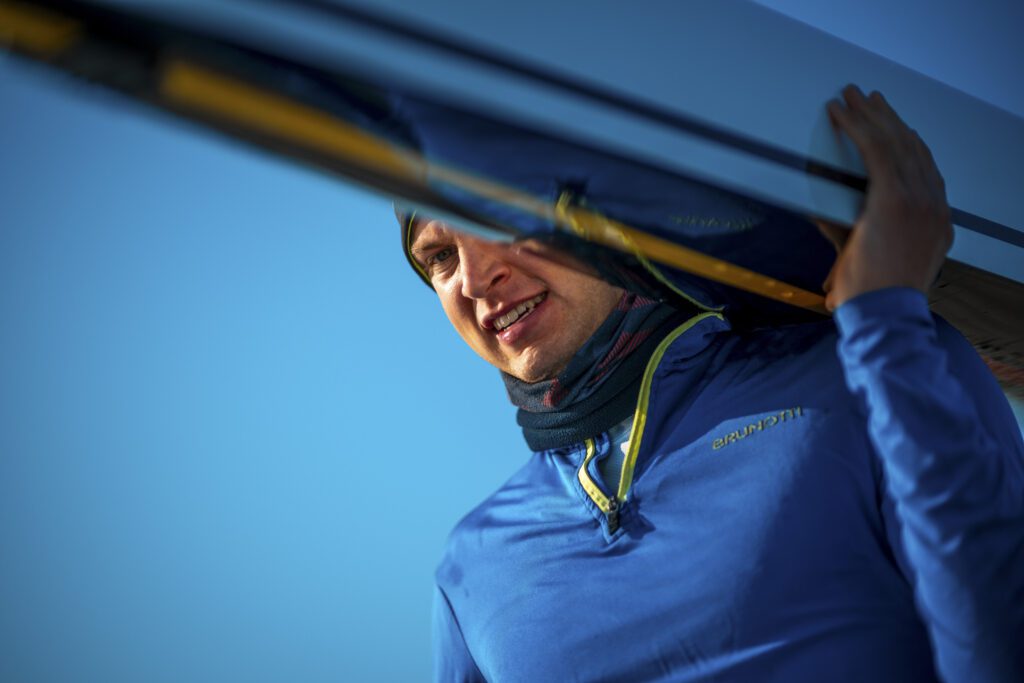The 2k erg has always been and forever will be a daunting task. No matter how fast or strong, there’s no escaping the pain. The thought of having to do a 2k elicits a variety of emotions, anxiety being the most common. If you’re like most rowers, you think (or maybe obsess) about your 2k long before doing it. While a 2k is always going to be painful, it doesn’t have to be something you dread. Overcoming your demons starts with understanding what causes them in the first place.
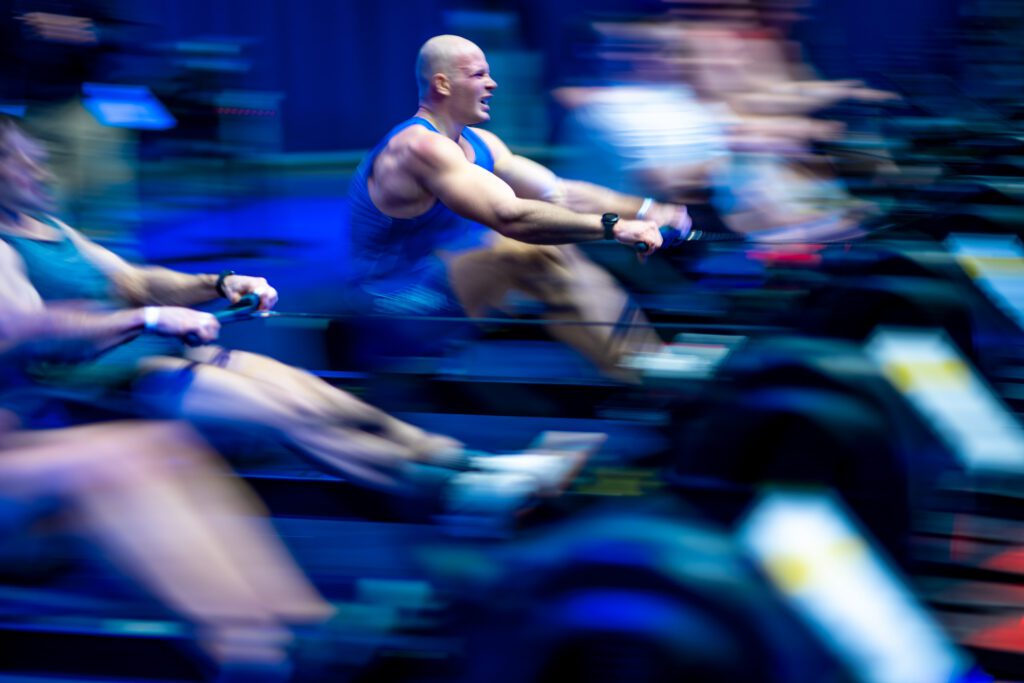
Photo Finland’s Joel Naukkarinen competes at the 2023 World Rowing Indoor Championships.
Credit Benedict Tufnell
Before getting into specifics, it’s important to understand the difference between the brain and the mind. So here’s a quick biology lesson. We often use the terms interchangeably, but the brain and mind are different. The brain is an organ protected by your scull that is the epicentre of the nervous system, a collection of billions of neurons that control and regulate everything in your body.
The mind, however, is harder to explain because it’s not a physical thing. You can’t see it or touch it. Rather, the mind is the collections of all your mental processes like thinking, feeling, remembering, learning, and judging. It’s that little voice inside your head.
“Few pleasures in life revival the moments after a 2k.”
Dr. David Schary
There are philosophical debates about the role of the brain versus the mind, but most scientists and psychologists agree that the two are inseparable and shape each other. Neural processes in the brain drive the mind’s mental processes and vice versa. For example, a happy thought or memory will activate neurons in the brain triggering the release of chemicals and hormones which make physiological changes in your body that your mind then interprets as pleasant.
This all relates back to the 2k because your performance has a lot to do with the way your mind reacts to the biological changes activated by the brain. So, is it possible to hack the 2k? To answer this, let’s break the 2k into three parts – pre-2k, during the 2k, and post-2k – because your brain does different things in each part, which affects your mind’s interpretation.
“Pain is interesting because it’s both objective and subjective.”
Dr. David Schary
Pre-2k
A 2k is stressful. As a result, it sets off the body’s natural fight-or-flight reaction. The brain reacts to these types of stressful situations by pumping chemicals like adrenaline and cortisol into your bloodstream. This causes a series of dramatic physiological changes like increasing your heart rate, dilating your pupils, and increasing tension in the muscles as they prepare to move.
These sensations reflect your body’s arousal level or activation state. The feelings will become more intense the closer you get to starting, peaking just before the first stroke. You might describe this dynamic state as feeling nervous, scared, hyped, or as having butterflies in your stomach.
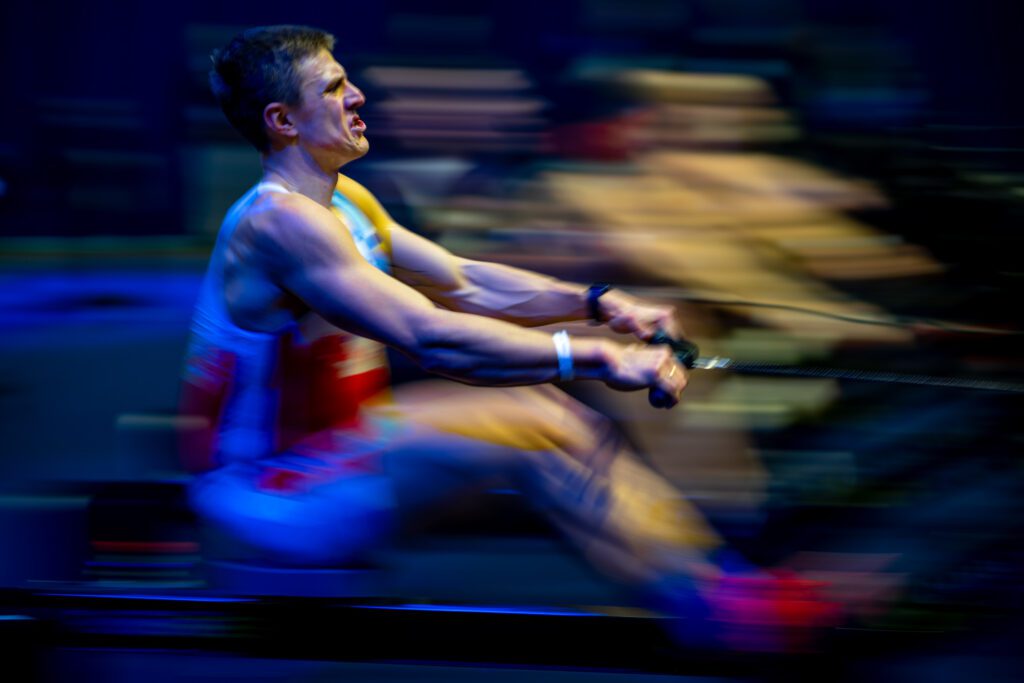
Photo Poland’s Macieja Zawojskiego competes at the 2023 World Rowing Indoor Championships.
Credit Benedict Tufnell
Almost all rowers experience this fight-or-flight reaction, or heightened state of activation. But they differ in their interpretation of these feelings. It’s like looking at a sunset through tinted glasses. The actual colors of the sunset don’t change, but the tinted glasses change the way you see the colours. If you interpret the activation state as negative, you’ll likely get anxious and scared. The voice inside your head will tell you that you’re not ready or that you will perform poorly.
Alternatively, if you interpret the sensations as a nervous excitement, a sign that you’re ready to go, you’ll likely be energized and ready to race. The feelings don’t change, only the story you tell yourself about them.
Your interpretation is based on a variety of things like pain tolerance, personality, confidence, previous performances or memories, expectations or goals, mood, and injuries.
During the 2k
During the 2k, your central nervous system kicks into overdrive. The brain tries to process the sudden and intense physiological demands placed on the body. And within seconds, you begin to feel pain that will only increase throughout the 2k.
Pain is interesting because it’s both objective and subjective. You have pain receptors all over your body that send messages up to the brain. Through a process called nociception, the nervous system detects and reports potentially harmful stimuli to the brain. Your brain then takes that information and interprets it to determine what to do. For example, the starting sequence at the beginning of the race sends signals to the brain that something abnormal is happening. Combining these signals with other physiological information, you begin to feel your legs burning.
“Intense exercise triggers the brain to release endorphins.”
Dr. David Schary
While the process of nociception is objective, your perception of the sensations is subjective. Just like the pre-2k activation state, your mind will interpret the burning in your legs as pain. Your perception of the pain (for example the amount and the intensity) will then determine your behaviour. In general, the more pain you feel, the less likely you are to continue.
As a side note, the subjectivity makes measuring pain difficult. It’s virtually impossible to tell if two people are feeling the same amount of pain. So, in the end, you are the only person that can say if, and how much, something hurts.
Now some people have a high pain tolerance, meaning their perception of pain is lower than the norm. This allows them to endure higher intensity levels for longer periods of time. While considering physiological factors like VO2 max and muscle strength, a high pain tolerance will allow a rower to maintain lower splits and faster stroke rates for longer periods of time.
Finally, we have a lot of emotion tied up with pain. Depending on past experiences, being in pain can trigger a host of physiological reactions.
Post-2k
There are few pleasures in life that revival the moments after a 2k. The intense exercise triggers the brain to release endorphins, natural chemicals that do the double duty of reducing the perception of pain and triggering feelings of euphoria. High intensity exercise results in a significant boost in the release of endorphins compared with moderate-intensity exercise. This is likely why you feel so good immediately after a 2k as opposed to longer but less intense workouts.
“We have a lot of emotion tied up with pain.”
Dr. David Schary
Hacking the 2k
Understanding how your brain and mind work during a 2k will allow you to implement good hacks or useful research-backed strategies to improve your performance. While this is not an exhaustive list of what you can do to improve, it will give you a jump start. Take what works for you and modify as necessary.
- Build Your Confidence
Perhaps the most important thing you can do to improve your 2k is to improve your confidence. The more confident you are about your ability, the less likely you’ll be to interpret your body’s activation level as negative. You’ll be more excited, and feel like you are ready to go.

Photo Swedish athlete enjoying the post-2k buzz.
Credit Benedict Tufnell
Success builds confidence. If you’ve done it before, you’re likely to believe you can do it again. The key to building success, especially if you are a novice or going through a slump, is to set structured, specific, and realistic goals. If you struggle with a 2k on or off the water, begin with setting goals for time or splits with shorter distances like 250 or 500 meters. Then as you meet your goals, gradually increase the meters, working your way up to 2000 meters. Mini-successes will build a foundation of confidence.
- Improve Your Fitness
Another pre-2k hack shifts the attention away from the brain to the body. Improving your fitness level will do a couple of things to help your mental state. First, getting more aerobically fit or increasing your strength will allow you to push harder for longer periods of time. This will increase your confidence to perform well on the 2k. But you must build in proper recovery. Increased training without enough recovery time can lead to slower times, as well as increase the risk of burnout or injury.
A higher fitness level also means a higher pain tolerance. Regular exercise has been shown to increase an individual’s pain threshold, or the point of exertion that they start to perceive pain. This will help you push through those difficult parts of the 2k.
- Focus Your Attention
Once you start the 2k, you want to limit any distractions and adopt an internal focus. Pay attention to your body, technique, and goals. This means eliminating, or at the very least minimizing, external distractions like music, podcasts, videos, or anything else that takes your attention away from the task.
Focusing on your body means paying attention to the little and big sensations. Feel your feet pushing off the foot stretchers, the breath going in and out of your lungs, and even the pain building in your quadriceps. Tuning into your body gives you a better indication of how hard you can push and for how long.
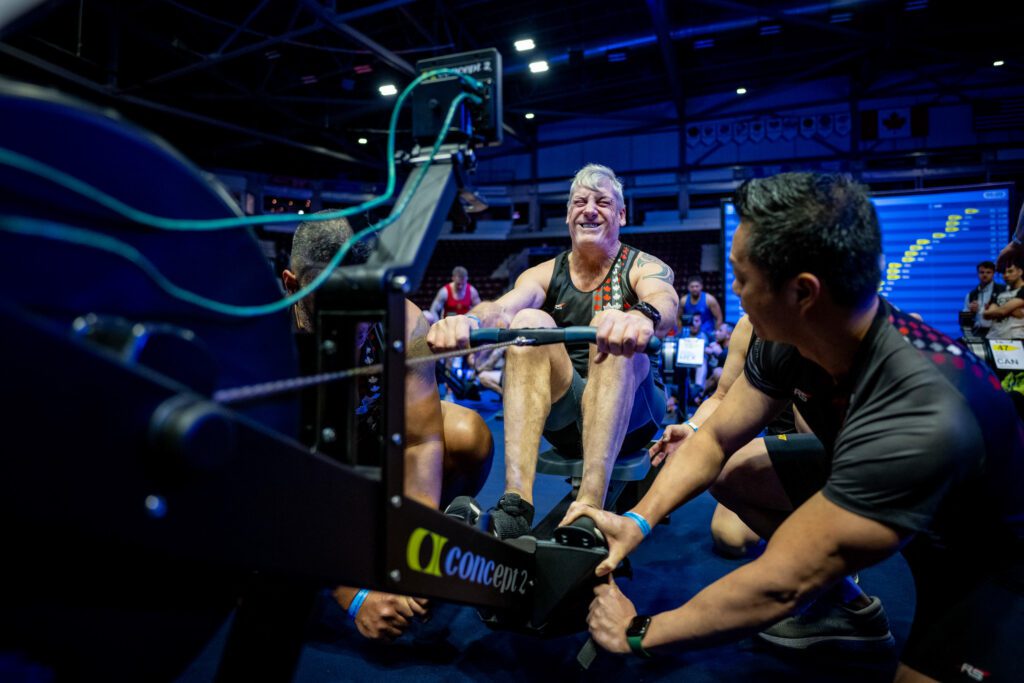
Photo Pain face mid-2k at the 2023 World Rowing Indoor Championships.
Credit Benedict Tufnell
When you turn your attention inward, be a curious observer without any judgement or commentary. If you feel pain, be curious about it. Explore it. Accept it, don’t try to force it out by distracting your mind. It sounds counterintuitive, but it will help you push through when things get hard.
Similarly, focusing on your technique can help you avoid some of the pitfalls that cost time like rushing up the slide when you get tired. Pick one or two things to focus your attention on for a series of strokes. A teammate or coxswain can also help you with cues. Just like with your body, observe your technique without judgement. If something is wrong, do your best to fix it but don’t worry if it’s not working.
Finally, a focus on your goals can help you improve throughout the 2k, especially if you have specific and realistic goals for each 500 meters. For example, you might want to hold a certain split or stroke rate. Attaining each goal can boost your confidence, helping you feel good about yourself in the middle of the 2k. But again, be an observer and don’t get concerned if you miss a goal. It’s just feedback, so you can revise mid-2k to help you finish stronger.
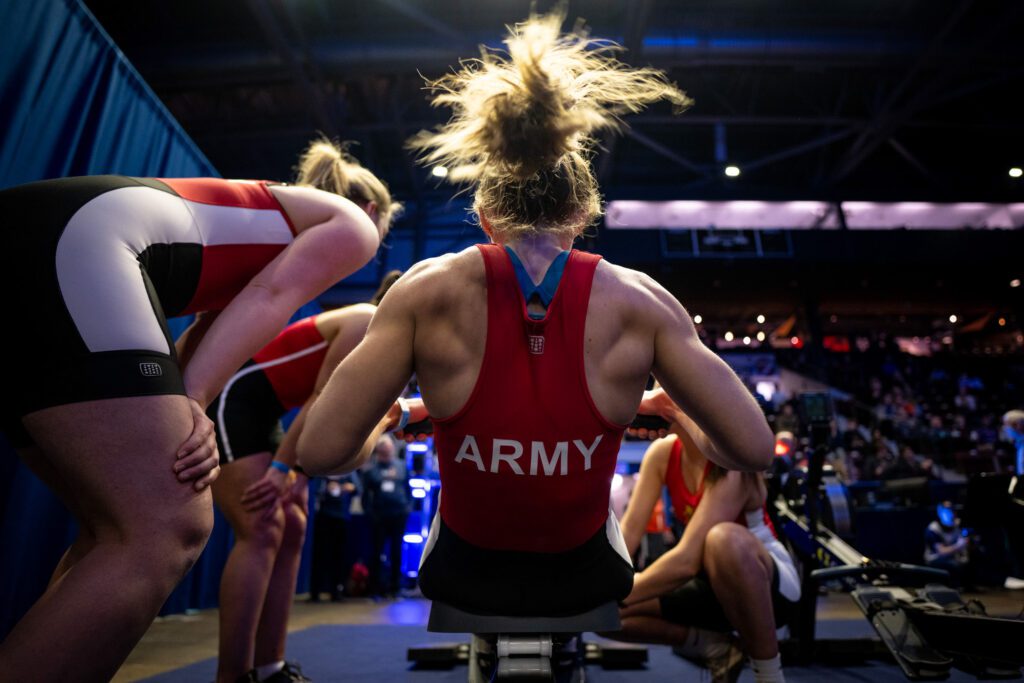
Photo British army rower racing at the 2023 World Rowing Indoor Championships.
Credit Benedict Tufnell
- Compete With Others
For most rowers, especially it you’re hyper-competitive, racing against others will push you to go faster. It’s fun and usually takes your mind off the more unpleasant parts of the 2k.
This happens for a variety of reasons but the most important thing to remember is to not let the desire to win push you past your limits. It is easy to go out too hard when you are racing someone else because you want to win or post the fastest time. This is not bad per se, but it can lead to some bad decisions like starting too fast. To avoid these pitfalls, it is best to compete against rowers who are about your speed or a little faster. Also, stick to your goals as best you can.
In the end, the 2k will always be hard. But you can improve by understanding your strengths and weaknesses. Then it is a process of applying the right strategies, practicing them over time, and enjoying setting new personal records.
2023 World Rowing Indoor Championships, in pictures
References
- Dove, M. J. (2019). Exploring how self-efficacy influences performance in collegiate club rowing athletes during a 2,000 meter ergometer test (Publication No. 13862454). [Doctoral dissertation, California State University, Long Beach]. ProQuest Dissertation Publishing.
- Jamieson, J. P., Black, A. E., Pelaia, L. E., Gravelding, H., Gordils, J., & Reis, H. T. (2022). Reappraising stress arousal improves affective, neuroendocrine, and academic performance outcomes in community college classrooms. Journal of Experimental Psychology: General, 151(1), 197–212.
- Reeve, J. (2005). Understanding motivation and emotion (4th ed.). Wiley.
- Rich, J., Pottratz, S. T., & Leaf, B. (2021). Understanding the unique psychological demands of competitive collegiate rowing: A guide for practitioners. Journal of Sport Psychology in Action, 12(1), 42-53.
- Smith, R.E. (1980). A cognitive-affective approach to stress management training for athletes. In A. Nadeau (Ed.), Psychology of motor behavior and sport (pp. 54-72). Human Kinetics.
THIS ARTICLE FIRST APPEARED IN



